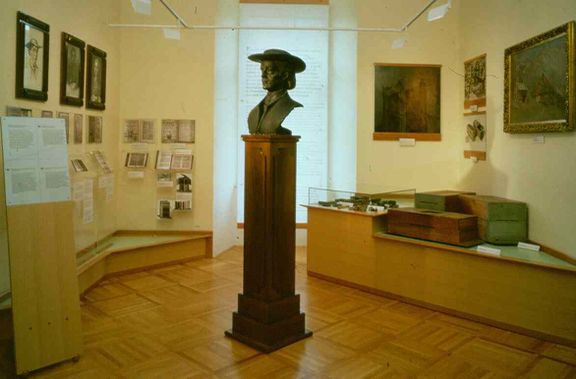Difference between revisions of "Museum of Apiculture, Radovljica"
Janez Premk (talk | contribs) |
Janez Premk (talk | contribs) |
||
| Line 21: | Line 21: | ||
{{Teaser| | {{Teaser| | ||
| − | + | [[Radovljica Apiculture Museum]], located in Baroque Thurn Mansion in the historic centre of Radovljica (together with [[Radovljica Municipal Museum]]), was founded in [[established:: 1959]] by the executive committee of the Beekeepers' Association of Slovenia in response to an appeal in the journal Slovenski čebelar (Slovene Beekeeper) to collect more material on the ancient practice of beekeeping. | |
}} | }} | ||
| + | |||
| + | == Background == | ||
| + | The museum was incorporated into [[Radovljica Municipality Museums]] in 1963, thoroughly renovated in 1973 and again in 1996. | ||
| + | |||
| + | The Thurn Mansion was rebuilt in Baroque style by the Counts of Thurn-Valsassina, who owned the manor in the period 1618-1840. The facade of the building is richly stuccoed, and the south western portal is accentuated with strongly schematised busts of the count's family. Some sections of the adjacent French-modelled Baroque park (once known to locals as 'paradise') which once belonged to the manor have been preserved. | ||
| + | |||
| + | == Programme == | ||
| + | The museum takes care of Slovenian beekeeping heritage, keeping records of it, collecting, storing, documenting, representing and popularizing it. | ||
| + | |||
| + | It displays the rich tradition of Slovenian apiculture or beekeeping which was an important branch of agriculture in the 18th and 19th centuries. The technical section of the museum shows the most typical habitats of bees and apicultural tools, the biological room highlights the life and work of the autochthonous bee kranjska sivka (apis mellifera carnica), the art exhibition features a unique Slovenian folk art, painted beehive front boards. A copy of the apiary of the famous beekeeper Anton Janša (1734-73) has been installed in nearby Breznica. | ||
| + | |||
| + | Beside the permanent exhibition on Slovenian apiculture there are also workshops and temporary exhibitions organised by the museum; in 2009 exhibition on Beekeeping in Gorenjska and Dolenjska region in co-organisation with [[Dolenjska Museum, Novo mesto]]. | ||
| + | |||
| + | == See also == | ||
| + | * [[Radovljica Municipality Museums]] | ||
| + | |||
| + | == External links == | ||
| + | * [http://www.muzeji-radovljica.si/4m_cebelarski/4cebelarski_uvod-en.html Radovljica Apiculture Museum website] | ||
| + | * [http://www.muzeji-radovljica.si/4m_cebelarski/4cebelarski_v_vodnik.html Virtial Guide to Radovljica Apiculture Museum] | ||
| + | |||
[[Category:Museums]] | [[Category:Museums]] | ||
Revision as of 10:46, 4 February 2010
-
11 Apr 2024
The exhibition "Buzzing Slovenia: About Bees and people" will be concluding with an international symposium "Bees for Peace - Čebele za mir". Amongst the speakers will be Kristina Seljak, the curator of Museum of Apiculture, Radovljica, and Gorazd Trušnovec, president of Slovene Urban Beekeepers' Association. The events are held in honor of the World Bee Day and the symposium is organised by Museum Europäischer Kulturen, Embassy of the Republic of Slovenia Berlin and Slovenian Cultural Centre in Berlin.
-
to
13 Jun 2023
14 Apr 2024
Exhibition Buzzing Slovenia: of Bees and People, held as part of the 19th European Culture Days, showcasing the traditions of Slovenian beekeeping and innovations in the fields of urban beekeeping and sustainable design. Co-organised by the SKICA Berlin, Embassy of the Republic of Slovenia Berlin, Slovene Ethnographic Museum and Radovljica Apiculture Museum.
-
to
13 Jun 2023
13 Jun 2023
Opening of the 2023 Slovenian Cultural Days in the framework of the 19th European Culture Days with the concert by Mirna Bogdanović, an awarded Bosnia-Slovenian jazz singer, and presentation of Slovenia by the Slovenian Tourist Board. Co-organised by the SKICA Berlin, Embassy of the Republic of Slovenia Berlin, Slovene Ethnographic Museum and Radovljica Apiculture Museum.
Background
The museum was incorporated into Radovljica Municipality Museums in 1963, thoroughly renovated in 1973 and again in 1996.
The Thurn Mansion was rebuilt in Baroque style by the Counts of Thurn-Valsassina, who owned the manor in the period 1618-1840. The facade of the building is richly stuccoed, and the south western portal is accentuated with strongly schematised busts of the count's family. Some sections of the adjacent French-modelled Baroque park (once known to locals as 'paradise') which once belonged to the manor have been preserved.
Programme
The museum takes care of Slovenian beekeeping heritage, keeping records of it, collecting, storing, documenting, representing and popularizing it.
It displays the rich tradition of Slovenian apiculture or beekeeping which was an important branch of agriculture in the 18th and 19th centuries. The technical section of the museum shows the most typical habitats of bees and apicultural tools, the biological room highlights the life and work of the autochthonous bee kranjska sivka (apis mellifera carnica), the art exhibition features a unique Slovenian folk art, painted beehive front boards. A copy of the apiary of the famous beekeeper Anton Janša (1734-73) has been installed in nearby Breznica.
Beside the permanent exhibition on Slovenian apiculture there are also workshops and temporary exhibitions organised by the museum; in 2009 exhibition on Beekeeping in Gorenjska and Dolenjska region in co-organisation with Dolenjska Museum, Novo mesto.




